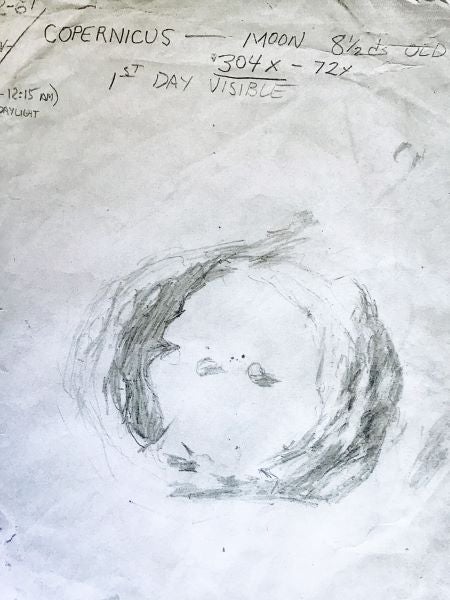At least, not usually. Most deep-space objects look frozen, as if the cosmos is being run as a wax museum. If only someone could snap one picture of the Orion Nebula every thousand years and thereby create a movie with sped-up motion. What grandeur would materialize! We’d then see swirling animated eddies and intense blue stars popping into view like holiday lights.
Instead, most of our eyepiece vistas are as unchanging as the vacation slides my uncle sadistically made us watch on repeat. A static scene is not a storyline. But there are exceptions. One of them offers a secret narrative available to anyone who knows how to read it. It’s the Moon!
Not long ago, lunar features looked dramatic and cool but told me no story beyond the obvious fact that our nearest neighbor has been badly mistreated. Then, 60 years after I made the pencil sketch shown on this page, I finally awakened to the storyline hovering in the eyepiece. It’s an epic narrative that, thanks to lunar research such as that done by the Apollo program, lets us create an actual chronicle of what the Moon has experienced since its birth. And because the violence that happened there was unfolding here at the same time, it’s a history that helps make sense of our own planet’s impacts and mass extinctions.
Start with the Moon’s dark blotches, the only features easily seen with the unaided eye. Each solidified lava flow, called a mare (MAR-ay), started with an enormous impact around 4 billion years ago. They’re vivid through binoculars. If you observe from the Northern Hemisphere, look for a small, round, isolated mare near the Moon’s right limb. This is Mare Crisium, the Sea of Crises. To its left, two large blotches form a crude figure 8, with the Sea of Tranquillity on the bottom and the smoother-edged Sea of Serenity at the top. The small mare beneath them is the Sea of Nectar.
Mare Nectaris, that Sea of Nectar, is one of the Moon’s oldest visible features, at about 3.9 billion years. Its formation marks the beginning of the Nectarian period. Anything earlier comprises the pre-Nectarian. At the other end of the chronological yardstick is Mare Imbrium, the biggest round blotch at the top, or north part, of the Moon. It formed after most other maria, making it younger, and dates from around 3.8 billion years ago. That timestamp thus marks the end of the Nectarian and the beginning of the Imbrian period.
Picture each mare as an enormous meteorite impact creating a vast depression that soon filled with hot, dark, iron-rich magma. And sometimes the bowl didn’t quite get filled: Mare Imbrium’s center is the lowest spot on the Moon. But then things quieted down and no blotches were made in the past 3 billion years. So, craters now carry our story forward. Lava covered up many of the oldest ones. And, logically, all craters seen on top of the dark mare basins are automatically newer.
There are other clues to crater ages, too. The bottom (southern) part of the Moon is the highlands, where lava never flowed. It’s old terrain, and its craters have a weathered look, with worn-down rims and intrusions by smaller, newer craters. Erosion came from tiny meteorites hammering the surface for eons. But keep looking, and you’ll see craters, like Eratosthenes, which do have sharp rims and an absence of superposed craterlets. If a fresh, sharp crater is not bright and white around Full Moon, and doesn’t have white rays streaming away from it, it dates from 1 billion to 3 billion years ago — the Eratosthenian period. (Try saying it with emphasis on the fourth, stretched-out theen syllable.)
Finally let’s turn to the newest chapter, the last billion years. These youngest craters have sharp rims, no superposed craterlets, bright interiors around Full Moon, and straight white lines radiating from them. Copernicus is typical — a meteorite created it just 0.8 billion years ago. So is Tycho, whose lengthy white rays dominate the Full Moon. It’s only 100 million to 200 million years old. This most recent era — still in progress — is the Copernican period.
Pre-Nectarian, Nectarian, Imbrian, Eratosthenian, and Copernican. Now you know all five lunar geological periods and how to recognize them when your telescope explores the Moon, chapter by nightly chapter, as a history book.










